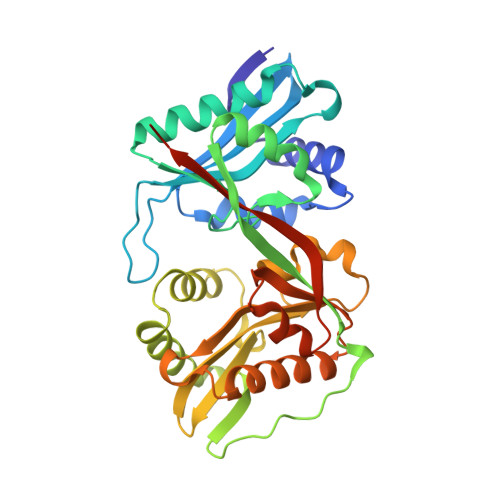Structural Studies on a Glucosamine/Glucosaminide N-Acetyltransferase.
Dopkins, B.J., Tipton, P.A., Thoden, J.B., Holden, H.M.(2016) Biochemistry 55: 4495-4508
- PubMed: 27348258
- DOI: https://doi.org/10.1021/acs.biochem.6b00536
- Primary Citation of Related Structures:
5KF1, 5KF2, 5KF8, 5KF9, 5KGA, 5KGH, 5KGJ, 5KGP - PubMed Abstract:
Glucosamine/glucosaminide N-acetyltransferase or GlmA catalyzes the transfer of an acetyl group from acetyl CoA to the primary amino group of glucosamine. The enzyme from Clostridium acetobutylicum is thought to be involved in cell wall rescue. In addition to glucosamine, GlmA has been shown to function on di- and trisaccharides of glucosamine as well. Here we present a structural and kinetic analysis of the enzyme. For this investigation, eight structures were determined to resolutions of 2.0 Å or better. The overall three-dimensional fold of GlmA places it into the tandem GNAT superfamily. Each subunit of the dimer folds into two distinct domains which exhibit high three-dimensional structural similarity. Whereas both domains bind acetyl CoA, it is the C-terminal domain that is catalytically competent. On the basis of the various structures determined in this investigation, two amino acid residues were targeted for further study: Asp 287 and Tyr 297. Although their positions in the active site suggested that they may play key roles in catalysis by functioning as active site bases and acids, respectively, this was not borne out by characterization of the D287N and Y297F variants. The kinetic properties revealed that both residues were important for substrate binding but had no critical roles as acid/base catalysts. Kinetic analyses also indicated that GlmA follows an ordered mechanism with acetyl CoA binding first followed by glucosamine. The product N-acetylglucosamine is then released prior to CoA. The investigation described herein provides significantly new information on enzymes belonging to the tandem GNAT superfamily.
Organizational Affiliation:
Department of Biochemistry, University of Wisconsin , Madison, Wisconsin 53706, United States.

















